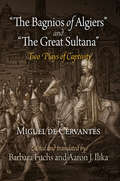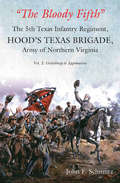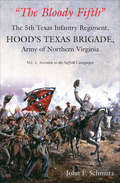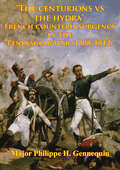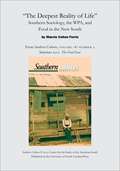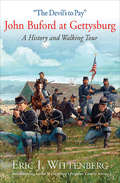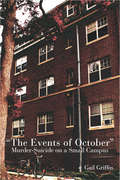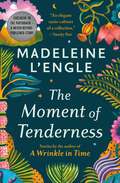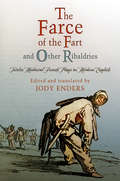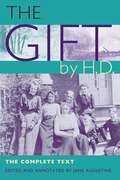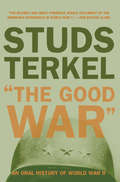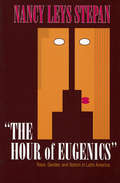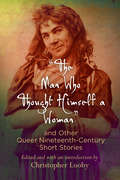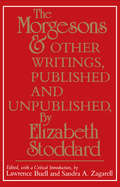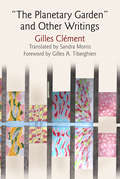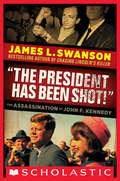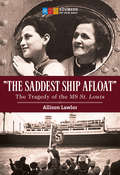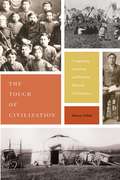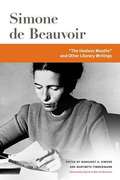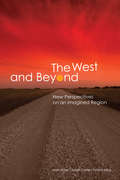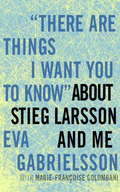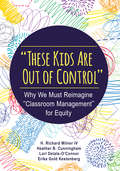- Table View
- List View
"The Bagnios of Algiers" and "The Great Sultana"
by Miguel De Cervantes Barbara Fuchs Aaron J. IlikaBest known today as the author of Don Quixote--one of the most beloved and widely read novels in the Western tradition--Miguel de Cervantes Saavedra (1547-1616) was a poet and a playwright as well. After some early successes on the Madrid stage in the 1580s, his theatrical career was interrupted by other literary efforts. Yet, eager to prove himself as a playwright, shortly before his death he published a collection of his later plays before they were ever performed.With their depiction of captives in North Africa and at the Ottoman court, two of these, "The Bagnios of Algiers" and "The Great Sultana," draw heavily on Cervantes's own experiences as a captive, and echo important episodes in Don Quixote. They are set in a Mediterranean world where Spain and its Muslim neighbors clashed repeatedly while still remaining in close contact, with merchants, exiles, captives, soldiers, and renegades frequently crossing between the two sides. The plays provide revealing insights into Spain's complex perception of the world of Mediterranean Islam.Despite their considerable literary and historical interest, these two plays have never before been translated into English. This edition presents them along with an introductory essay that places them in the context of Cervantes's drama, the early modern stage, and the political and cultural relations between Christianity and Islam in the early modern period.
"The Bloody Fifth": Gettysburg to Appomattox (The 5th Texas Infantry Regiment, Hood's Texas Brigade, Army of Northern Virginia #2)
by John SchmutzThe second installment in a sweeping history of the 5th Texas InfantryThe Bloody Fifthone of only three Texas regiments to fight with Robert E. Lees Army of Northern Virginia. The 5th Texas established an exceptional combat record in an army known for its fighting capabilities. The regiment took part in 38 engagements, including nearly every significant battle in the Eastern Theater, as well as the Chickamauga, Chattanooga, and Knoxville campaigns in the Western Theater. The Bloody Fifth offers the first full-length study documenting this fabled regimental command.The first volume, Secession through the Suffolk Campaign, followed the regiment from its inception through the successful foraging campaign in southeastern Virginia in April 1863. Gettysburg to Appomattox continues the regiments rich history from its march north into Pennsylvania and the battle of Gettysburg, its transfer west to Georgia and participation in the bloody battle of Chickamauga, operations in East Tennessee, and the regiments return to Virginia for the overland battles (Wilderness to Cold Harbor), Petersburg campaign, and the march to Appomattox Court House. The narrative ends by following many of the regiments soldiers on their long journey home.Schmutzs definitive study is based upon years of archival and battlefield research that uncovered hundreds of primary sources, many never before used. The result is a lively account of not only the regiments marches and battles but a personal look into the lives of these Texans as they struggled to survive a vicious war more than 1,000 miles from home.The Bloody FifthThe 5th Texas Infantry Regiment, Hoods Texas Brigade, Army of Northern Virginia, with photos, original maps, explanatory footnotes, and important and useful appendices, is a significant contribution to the history of Texas and the American Civil War.
"The Bloody Fifth": The 5th Texas Infantry, Hood's Texas Brigade, Army Of Northern Virginia (The 5th Texas Infantry Regiment, Hood's Texas Brigade, Army of Northern Virginia #1)
by John F. SchmutzThe 5th Texas InfantryThe Bloody Fifthwas one of only three Texas regiments to fight with Robert E. Lees Army of Northern Virginia. Much like the army in which it served, the 5th Texas established a stellar combat record. The regiment took part in 38 engagements, including nearly every significant battle in the Eastern Theater, as well as the Chickamauga, Chattanooga, and Knoxville campaigns in the Western Theater. John F. Schmutzs The Bloody Fifth: The 5th Texas Infantry, Hoods Texas Brigade, Army of Northern Virginia is the first full-length study to document this fabled regimental command.The Bloody Fifth presents the regiments rich history from the secession of the Lone Star State and the organization of ten independent east and central Texas companies, through four years of arduous marching and fighting. The 5th Texass battlefield exploits are legendary, from its inaugural fighting on the Virginia peninsula in early 1862 through Appomattox. At Gettysburg, the Texans suffered horrendous losses repeatedly assaulting Little Round Tops rocky slopes, and in the Wilderness on May 6, 1864, helped save the collapsing Confederate line while the eyes of General Lee were upon them. But it was at Second Manassas where the regiment earned its enduring nickname by attacking and crushing the 5th New York Zouaves. Flushed with victory, the Texans pushed through the disintegrating Federal lines and outdistanced the remainder of the Brigadeas well as the rest of the Confederate army. In his official report on the battle, Gen. John Bell Hood, boasted that the 5th Texas had slipped the bridle. Its exploits that day earned the regiment its undying sobriquet The Bloody Fifth.Schmutzs monumental regimental history, which also details the personal lives of these Texas soldiers as they struggled to survive the war some 2,000 miles from home, is based upon years of archival research that has uncovered hundreds of primary sources. Complete with photos and original maps, The Bloody Fifth: The 5th Texas Infantry, Hoods Texas Brigade, Army of Northern Virginia is a significant contribution to the growing literature of the Civil War.
"The Centurions Vs The Hydra": French Counterinsurgency In The Peninsular War (1808-1812)
by Major Philippe H. GennequinConsidered the first documented commitment of a Western-style army facing a nation-wide insurgency, the Peninsular War deserves a critical examination of French pacification methods. In spite of a severe defeat, the Grande Armee achieved success while conducting counterinsurgency operations in Aragon and Andalusia. Based on Spanish, French and British primary sources, this thesis intended to examine if these results were connected to the personality of great commanders, flexible small unit leaders, or external factors. The underlying rationale was also to produce a broader picture on French counterinsurgency while bridging the imperial experience with the colonial period. The comparison of Marshal Soult and Marshal Suchet's case-studies demonstrated that French officers solved their operational dilemma in different manners. But the analysis also outlined a common denominator to their practices. Leverage of religion, build-up of native security forces, and development of an influence-driven campaign constituted the major tenets of this nascent doctrine of counterinsurgency.
"The Deepest Reality of Life": Southern Sociology, the WPA, and Food in the New South
by Marcie Cohen Ferris“‘I know your damned photographer’s soul writhes, but to hell with it. Do you think I give a damn about a photographer’s soul with Hitler at our doorstep?’” This article appears in the Summer 2012 issue of Southern Cultures. The full issue is also available as an ebook. Southern Cultures is published quarterly (spring, summer, fall, winter) by the University of North Carolina Press. The journal is sponsored by the University of North Carolina at Chapel Hill’s Center for the Study of the American South.
"The Devil's to Pay": John Buford at Gettysburg: A History and Walking Tour
by Eric J. WittenbergAn award-winning Civil War historian’s profile of the brilliant Union cavalry officer and the strategies he employed to prevent catastrophe at Gettysburg. The Battle of Gettysburg turned the tide of the Civil War. But the outcome of the decisive confrontation between North and South might have been dramatically different if not for the actions of Brig. Gen. John Buford, commander of the Union army’s First Cavalry Division. An award-winning chronicler of America’s War between the States and author of more than a dozen acclaimed works of historical scholarship, Eric J. Wittenberg now focuses on the iconic commanding officer known to his troops as “Honest John” and “Old Steadfast.” Wittenberg describes in fascinating detail the brilliant maneuvers Buford undertook to keep Gen. Robert E. Lee’s Confederate army at bay and later rescue what remained of the devastated First and Eleventh Corps.”The Devil’s to Pay” celebrates the stunning military achievements of an unparalleled tactical genius at the onset of the Gettysburg Campaign and paints an unforgettable portrait of a quiet, unassuming cavalryman who recognized a possible disaster in the making and took bold action to avert it. Based on a wealth of information from primary sources, “The Devil’s to Pay” includes pages of illustrations, maps, and photographs, as well as a walking and driving tour of the battlefield sites where America’s history was made at a staggeringly high cost in blood. A comprehensive tactical study that is both scholarly and eminently accessible, it is an essential addition to the library of any Civil War enthusiast.
"The Events of October": Murder-Suicide on a Small Campus (Painted Turtle)
by Gail GriffinThe true story of a murder-suicide at Kalamazoo College and its rippling effects on the campus community.
"The Fact of the Matter" - Free Short Story
by Madeleine L 'EngleEnjoy this free short story from award-winning author Madeleine L'Engle's newest book, The Moment of Tenderness, a collection of 18 short stories, some never before published. It was a frigid winter day when Old Mrs. Campbell stormed into the Franklins' general store, decrying the devilish nature of her daughter-in-law-a sentiment that deeply disturbed Mrs. Franklin, considering the woman in question, Alicia, was oft described as "saintly" by everyone around her. When she leaves the store in a huff, Mrs. Franklin thinks she's done with Mrs. Campbell's ravings for the day-until the woman calls her late in the night, urgently demanding to see her. Blending elements of fantasy and horror, what transpires between the two women over the course of the evening will test the boundaries of reason, faith, and family-and prove that, in times of great danger, even strangers can come together to help one another in need. For more stories by Madeleine L'Engle, read The Moment of Tenderness, available now.
"The Farce of the Fart" and Other Ribaldries
by Jody EndersWas there more to medieval and Renaissance comedy than Chaucer and Shakespeare? Bien sûr. For a real taste of saucy early European humor, one must cross the Channel to France. There, in the fifteenth and early sixteenth centuries, the sophisticated met the scatological in popular performances presented by roving troupes in public squares that skewered sex, politics, and religion. For centuries, the scripts for these outrageous, anonymously written shows were available only in French editions gathered from scattered print and manuscript sources. Now prize-winning theater historian Jody Enders brings twelve of the funniest of these farces to contemporary English-speaking audiences in "The Farce of the Fart" and Other Ribaldries. Enders's translation captures the full richness of the colorful characters, irreverent humor, and over-the-top plotlines, all in a refreshingly uncensored American vernacular.Those who have never heard the one about the Cobbler, the Monk, the Wife, and the Gatekeeper should prepare to be shocked and entertained. "The Farce of the Fart" and Other Ribaldries is populated by hilarious characters high and low. For medievalists, theater practitioners, and classic comedy lovers alike, Enders provides a wealth of information about the plays and their history. Helpful details abound for each play about plot, character development, sets, staging, costumes, and props. This performance-friendly collection offers in-depth guidance to actors, directors, dramaturges, teachers, and their students."The Farce of the Fart" and Other Ribaldries puts fifteenth-century French farce in its rightful place alongside Chaucer, Shakespeare, commedia dell'arte, and Molière--not to mention Monty Python. Vive la Farce!
"The Fat of the Land"
by Anzia YezierskaA mother goes from poverty to wealth, expecting happiness but only finding a cruel Catch-22. Anzia Yezierska wrote about the struggles of female Jewish immigrants in New York's Lower East Side. She confronted the cost of acculturation and assimilation among immigrants. Her stories provide insight into the meaning of liberation for immigrants—particularly Jewish immigrant women.
"The Gift" by H.D.: The Complete Text
by H. D."It is a special joy to have the complete text of The Gift, a stunning work in the H.D. canon, a work of import for studies in autobiography and the essay, for understanding the spiritual crisis of modernism, and as a climactic work in the career of an extraordinary 20th-century woman writer."--Rachel Blau DuPlessis, Temple University"All students and teachers of American literature will value this book for the light it throws on the poet who is, I believe, the most important female poet in America since Emily Dickinson, and indeed the most important female poet writing in the English language during the 20th century."--Louis L. Martz, Yale UniversityIn this complete, unabridged edition of H.D.'s visionary memoir, The Gift, Jane Augustine makes available for the first time the text as H.D. wrote it and intended it to be read, including H.D.’s coda to the book, her "Notes," never before published in its entirety.Written in London during the blitz of World War II, The Gift re-creates the peaceful childhood of Hilda Doolittle in Bethlehem, Pennsylvania, where she was born in 1886. As an antidote to war’s destructiveness, H.D. invokes the mystical Moravian heritage of her mother's family to convey an ideal world peace and salvation that would come through the spiritual power of women--a power that also endowed her with "the gift" of her own art.Although H.D.’s androgynous signature first associated her with early 20th-century Imagist poetics, The Gift exemplifies her continuing innovations in prose. She uses the child-voice, flashback, and stream-of-consciousness techniques reminiscent of Virginia Woolf, Gertrude Stein, and Dorothy Richardson, but expands the genre of memoir through free-associative meditations on myth and her lengthy essayistic "Notes" on Moravian history, emphasizing the pioneer missionaries' rapport with Native Americans..The Gift is key to intertextual studies of H.D.’s wartime oeuvre and to an understanding of the religious and gender concerns pervading her later work, especially the women-centered poems Trilogy and Helen in Egypt. Augustine’s introduction and annotations, based on extensive research in Moravian archives, provide a biographical and historical context to make this the definitive edition of The Gift, essential to students and scholars of H.D., modernism, and feminist literature.
"The Good War": An Oral History of World War II
by Studs TerkelWinner of the Pulitzer Prize: &“The richest and most powerful single document of the American experience in World War II&” (The Boston Globe). &“The Good War&” is a testament not only to the experience of war but to the extraordinary skill of Studs Terkel as an interviewer and oral historian. From a pipe fitter&’s apprentice at Pearl Harbor to a crew member of the flight that dropped the atomic bomb on Nagasaki, his subjects are open and unrelenting in their analyses of themselves and their experiences, producing what People magazine has called &“a splendid epic history&” of WWII. With this volume Terkel expanded his scope to the global and the historical, and the result is a masterpiece of oral history. &“Tremendously compelling, somehow dramatic and intimate at the same time, as if one has stumbled on private accounts in letters locked in attic trunks . . . In terms of plain human interest, Mr. Terkel may well have put together the most vivid collection of World War II sketches ever gathered between covers.&” —The New York Times Book Review &“I promise you will remember your war years, if you were alive then, with extraordinary vividness as you go through Studs Terkel&’s book. Or, if you are too young to remember, this is the best place to get a sense of what people were feeling.&” —Chicago Tribune &“A powerful book, repeatedly moving and profoundly disturbing.&” —People
"The Hour of Eugenics": Race, Gender, and Nation in Latin America
by Nancy Leys StepanEugenics was a term coined in 1883 to name the scientific and social theory which advocated "race improvement" through selective human breeding. In Europe and the United States the eugenics movement found many supporters before it was finally discredited by its association with the racist ideology of Nazi Germany. Examining for the first time how eugenics was taken up by scientists and social reformers in Latin America, Nancy Leys Stepan compares the eugenics movements in Mexico, Brazil, and Argentina with the more familiar cases of Britain, the United States, and Germany. In this highly original account, Stepan sheds new light on the role of science in reformulating issues of race, gender, reproduction, and public health in an era when the focus on national identity was particularly intense. Drawing upon a rich body of evidence concerning the technical publications and professional meetings of Latin American eugenicists, she examines how they adapted eugenic principles to local contexts between the world wars. Stepan shows that Latin American eugenicists diverged considerably from their counterparts in Europe and the United States in their ideological approach and their interpretations of key texts concerning heredity.
"The Man Who Thought Himself a Woman" and Other Queer Nineteenth-Century Short Stories
by Christopher Looby"Perhaps it is no coincidence that the nineteenth century--the century when, it has been said, sexuality as such (and various taxonomized sexual identities) were invented--is the period when American short stories were invented, and when they were the queerest."--Christopher Looby, from the IntroductionA man in small-town America wears the clothing of his wife and sisters; satisfied at last that he has "a perfect suit of garments appropriate for my sex," he commits suicide, asking only that he be buried dressed as a woman. A country maid has a passionate summer relationship with an heiress, the memory of which sustains her for the next forty years. A girl is carried by a strong wind to a place where she discovers that everything is made of candy, including the "queer people," whom she licks and eats. If these are not the kinds of stories we expect to find in nineteenth-century American literature, it is perhaps because we have been looking in the wrong places.The stories gathered here are written by a diverse assortment of writers--women and men, obscure and famous: Herman Melville, Willa Cather, Henry James, and Louisa May Alcott, among others. Exploring the vagaries of gender identity, erotic desire, and affectional attachments that do not map easily onto present categories of sex and gender, they celebrate, mourn, and question the different modes of embodiment and forgotten styles of pleasure of nineteenth-century America.
"The Morgesons" and Other Writings, Published and Unpublished
by Lawrence Buell Elizabeth Stoddard Sandra A. Zagarell"Stoddard was, next to Melville and Hawthorne, the most strikingly original voice in the mid-nineteenth-century American novel, a voice . . . that ought to gain a more sympathetic and perceptive hearing in our time than in her own."--from the IntroductionThe centerpiece of this volume is The Morgesons (1862), one of the few outstanding feminist bildungsromanae of that century. Additional selections include arresting short stories and provocative journalistic essays/reviews, plus a number of letters and manuscript journals that have never before been published. The texts are fully edited and documented.
"The Only True People": Linking Maya Identities Past and Present
by Bethany J. Beyyette and Lisa J. LeCount"The Only True People" is a timely and rigorous examination of ethnicity among the ancient and modern Maya, focusing on ethnogenesis and exploring the complexities of Maya identity—how it developed, where and when it emerged, and why it continues to change over time. In the volume, a multidisciplinary group of well-known scholars including archaeologists, linguists, ethnographers, ethnohistorians, and epigraphers investigate ethnicity and other forms of group identity at a number of Maya sites and places, from the northern reaches of the Yucatan to the Southern Periphery, and across different time periods, from the Classic period to the modern day. Each contribution challenges the notion of ethnically homogenous "Maya peoples" for their region and chronology and explores how their work contributes to the definition of "ethnicity" for ancient Maya society. Contributors confront some of the most difficult theoretical debates concerning identity in the literature today: how different ethnic groups define themselves in relation to others; under what circumstances ethnicity is marked by overt expressions of group membership and when it is hidden from view; and the processes that transform ethnic identities and their expressions. By addressing the social constructs and conditions behind Maya ethnicity, both past and present, "The Only True People" contributes to the understanding of ethnicity as a complex set of relationships among people who lived in real and imagined communities, as well as among people separated by social boundaries. The volume will be a key resource for Mayanists and will be of interest to students and scholars of ethnography, anthropology, and cultural studies as well. Contributors: McCale Ashenbrener, Ellen E. Bell, Marcello A. Canuto, Juan Castillo Cocom, David A. Freidel, Wolfgang Gabbert, Stanley P. Guente, Jonathan Hill, Charles Andrew Hofling, Martha J. Macri, Damien B. Marken, Matthew Restall, Timoteo Rodriguez, Mathew C. Samson, Edward Schortman, Rebecca Storey
"The Planetary Garden" and Other Writings (Penn Studies in Landscape Architecture)
by Gilles ClémentCelebrated landscape architect Gilles Clément may be best known for his public parks in Paris, including the Parc André Citroën and the garden of the Musée du Quai Branly, but he describes himself as a gardener. To care for and cultivate a plot of land, a capable gardener must observe in order to act and work with, rather than against, the natural ecosystem of the garden. In this sense, he suggests, we should think of the entire planet as a garden, and ourselves as its keepers, responsible for the care of its complexity and diversity of life."The Planetary Garden" is an environmental manifesto that outlines Clément's interpretation of the laws that govern the natural world and the principles that should guide our stewardship of the global garden of Earth. These are among the tenets of a humanist ecology, which posits that the natural world and humankind cannot be understood as separate from one another. This philosophy forms a thread that is woven through the accompanying essays of this volume: "Life, Constantly Inventive: Reflections of a Humanist Ecologist" and "The Wisdom of the Gardener." Brought together and translated into English for the first time, these three texts make a powerful statement about the nature of the world and humanity's place within it.
"The President Has Been Shot!": The Assassination Of John F. Kennedy
by James L. SwansonA breathtaking and dramatic account of the JFK assassination by the NEW YORK TIMES bestselling author of CHASING LINCOLN'S KILLER!In his new young-adult book on the Kennedy assassination, James Swanson will transport readers back to one of the most shocking, sad, and terrifying events in American history. As he did in his bestselling Scholastic YA book, CHASING LINCOLN'S KILLER, Swanson will deploy his signature "you are there" style -- a riveting, ticking-clock pace, with an unprecedented eye for dramatic details and impeccable historical accuracy -- to tell the story of the JFK assassination as it has never been told before.The book will be illustrated with archival photos, and will have diagrams, source notes, bibliography, places to visit, and an index.
"The Saddest Ship Afloat": The Tragedy of the MS St. Louis (Stories of Our Past)
by Allison LawlorA true story of hundreds of Jewish refugees and the sea journey they hoped would save them. On May 13, 1939, the eve of the Second World War, the MS St. Louis left port in Hamburg, Germany, headed for Havana, Cuba. Among the ship’s passengers were more than six hundred Jews attempting to escape Nazi rule. But most of the visas the passengers had purchased turned out to be fake, and after several days in limbo in Havana’s harbor, the ship’s captain turned back for Europe. Canadian and American activists petitioned their governments to accept the refugees on humanitarian grounds, but to no avail. On its return, the ship would distribute its passengers among European countries, and over the course of the war, an estimated 250 would die in Nazi concentration camps.This volume in the Stories of our Past series is illustrated with photos and sidebar features on the voyage, glimpses into the lives of passengers, a look at Canada’s postwar refugee policy, and memorials dedicated to preserving the story of this tragic event in Canadian immigration history.
"The Touch of Civilization": Comparing American and Russian Internal Colonization
by Steven SabolThe Touch of Civilization is a comparative history of the United States and Russia during their efforts to colonize and assimilate two indigenous groups of people within their national borders: the Sioux of the Great Plains and the Kazakhs of the Eurasian Steppe. In the revealing juxtaposition of these two cases author Steven Sabol elucidates previously unexplored connections between the state building and colonizing projects these powers pursued in the nineteenth century. This critical examination of internal colonization—a form of contiguous continental expansion, imperialism, and colonialism that incorporated indigenous lands and peoples—draws a corollary between the westward-moving American pioneer and the eastward-moving Russian peasant. Sabol examines how and why perceptions of the Sioux and Kazakhs as ostensibly uncivilized peoples and the Northern Plains and the Kazakh Steppe as “uninhabited” regions that ought to be settled reinforced American and Russian government sedentarization policies and land allotment programs. In addition, he illustrates how both countries encountered problems and conflicts with local populations while pursuing their national missions of colonization, comparing the various forms of Sioux and Kazakh martial, political, social, and cultural resistance evident throughout the nineteenth century. Presenting a nuanced, in-depth history and contextualizing US and Russian colonialism in a global framework, The Touch of Civilization will be of significant value to students and scholars of Russian history, American and Native American history, and the history of colonization.
"The Triple Whammy" and Other Russian Stories: A Memoir
by Luis MenasheAn American historian, film specialist, and documentary filmmaker shares candid stories of his life in Russia during and after the Cold War. A captivating lifetime of personal and professional experiences by an American historian, film specialist, and documentary filmmaker in the Soviet Union and post-Soviet Russia. The author&’s experiences as a radical in the turbulent 1960s, and his eventual disenchantment offer some precedents and perspectives to all those on the Left, Center, or Right interested in the fluctuations of American politics. The vivid log of hopes and disillusions is related in a candid, non-academic style, and set against a panorama of history and politics in the late twentieth century.&“A self-described scholar-activist, Menashe weaves together political, intellectual, and cultural currents of leftist life, and draws a vivid picture of people and places, life-changing adventures, the intellectual and political challenges of graduate school during the Cold War, encounters with key Russian literary and political figures, and much more. Then comes the crash, the Soviet Union&’s end. As in all failed love affairs, Menashe retains some sweet memories. The reader will taste them long after reading the memoir.&” —Carole Turbin, Professor Emerita, History and Sociology, SUNY/Empire State College
"The Useless Mouths" and Other Literary Writings
by Simone De Beauvoir Sylvie Le Beauvoir Margaret A. Simons Marybeth Timmermann"The Useless Mouths" and Other Literary Writings brings to English-language readers literary writings--several previously unknown--by Simone de Beauvoir. Culled from sources including various American university collections, the works span decades of Beauvoir's career. Ranging from dramatic works and literary theory to radio broadcasts, they collectively reveal fresh insights into Beauvoir's writing process, personal life, and the honing of her philosophy. The volume begins with a new translation of the 1945 play "The Useless Mouths," written in Paris during the Nazi occupation. Other pieces were discovered after Beauvoir's death in 1986, such as the 1965 short novel Misunderstanding in Moscow, involving an elderly French couple who confront their fears of aging. Two additional previously unknown texts include the fragmentary "Notes for a Novel," which contains the seed of what she later would call "the problem of the Other," and a lecture on postwar French theater titled "Existential Theater." The collection notably includes the eagerly awaited translation of Beauvoir's contribution to a 1965 debate among Jean-Paul Sartre and other French writers and intellectuals, "What Can Literature Do?" Prefaces to well-known works such as Bluebeard and Other Fairy Tales,La Bâtarde, and James Joyce in Paris: His Final Years are also available in English for the first time, alongside essays and other short articles. A landmark contribution to Beauvoir studies and French literary studies, the volume includes informative and engaging introductory essays by prominent and rising scholars. Contributors are Meryl Altman, Elizabeth Fallaize, Alison S. Fell, Sarah Gendron, Dennis A. Gilbert, Laura Hengehold, Eleanore Holveck, Terry Keefe, J. Debbie Mann, Frederick M. Morrison, Catherine Naji, Justine Sarrot, Liz Stanley, Ursula Tidd, and Veronique Zaytzeff.
"The West and Beyond"
by Sarah Carter Alvin Finkel Peter FortnaThe West and Beyond explores the state of Western Canadian history, showcasing the research interests of a new generation of scholars while charting new directions for the future and stimulating further interrogation of our past. This dynamic collection encourages dialogue among generations of historians of the West, and among practitioners of diverse approaches to the past. It also reflects a broad range of disciplinary and professional boundaries, offering new ways to understand the West.
"There Are Things I Want You to Know" about Stieg Larsson and Me
by Linda Coverdale Marie-Francoise Colombani Eva GabrielssonHere is the real inside story--not the one about the Stieg Larsson phenomenon, but rather the love story of a man and a woman whose lives came to be guided by politics and love, coffee and activism, writing and friendship. Only one person in the world knows that story well enough to tell it with authority. Her name is Eva Gabrielsson. Eva Gabrielsson and Stieg Larsson shared everything, starting when they were both eighteen until his untimely death thirty-two years later at the age of fifty. In "There Are Things I Want You to Know" about Stieg Larsson and Me, Eva Gabrielsson accepts the daunting challenge of telling the story of their shared life steeped in love and sharpened in the struggle for justice and human rights. She chooses to tell it in short, spare, lyrical chapters, like snapshots, regaling Larsson's readers with the inside account of how he wrote, why he wrote, who the sources were for Lisbeth and his other characters--graciously answering Stieg Larsson's readers' most pressing questions--and at the same time telling us the things we didn't know we wanted to know--about love and loss, death, betrayal, and the mistreatment of women.
"These Kids Are Out of Control": Why We Must Reimagine "Classroom Management" for Equity
by Dr H. Richard Milner Heather B. Cunningham Lori Delale-O'Connor Erica Gold KestenbergToday’s classrooms reimagined If you’re looking for a book on how to “control” your students, this isn’t it! Instead, this is a book on what classroom learning could be if we aspire to co-create more culturally responsive and equitable environments—environments that are safe, affirming, learner-centered, intellectually challenging, and engaging. If we create the kind of places where our students want to be . . . A critically important resource for teachers and administrators alike, “These Kids Are Out of Control” details the specific practices, tools, beliefs, dispositions, and mindsets that are essential to better serving the complex needs of our diverse learners, especially our marginalized students. Gain expert insight on: What it means to be culturally responsive in today’s classroom environments, even in schools at large How to decide what to teach, understand the curriculum, build relationships in and outside of school, and assess student development and learning The four best practices for building a classroom culture that is both nurturing and rigorous, and where all students are seen, heard, and respected Alternatives to punitive disciplinary action that too often sustains the cradle-to-prison pipeline Classroom “management” takes care of itself when you engage students, help them see links and alignment of the curriculum to their lives, build on and from student identity and culture, and recognize the many ways instructional practices can shift. “These Kids Are Out of Control” is your opportunity to get started right away!
